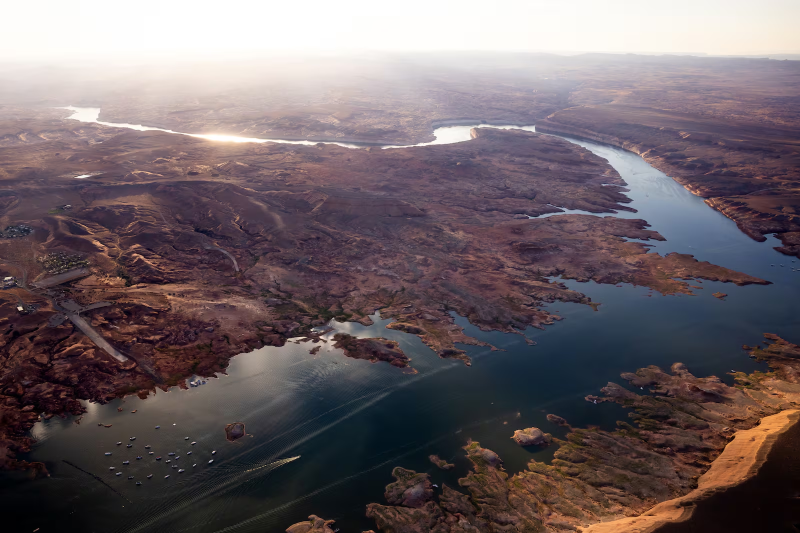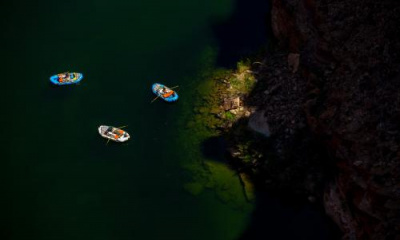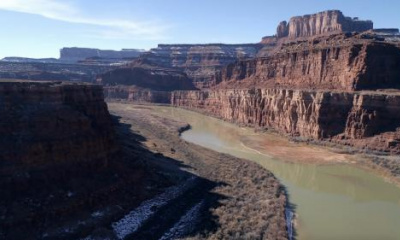‘The bottom line is we’re pursuing the opportunity to give credit where credit is due for this conserved water,’ Colorado River Authority of Utah Executive Director Amy Haas said
The issue of water — who gets it, how much they get and what happens when Mother Nature doesn’t provide enough — is not a new conflict in the Intermountain West.
Lake Powell in Glen Canyon National Park is the link in the multistate system that feeds the Colorado River from the upper basin states to its lower basin counterparts. In its trip, the Colorado River water, mainly provided by snowmelt from the Rocky Mountains, travels through the upper basin states comprising Colorado, Utah, Wyoming and New Mexico. It then flows through Lake Powell down to Lake Mead, feeding the lower basin states: Nevada, Arizona and California.
“Over the last two or so years, there’s been an upper basin-wide conservation program that basically pays water users, farmer in particular, to voluntarily forego irrigation for a season in an effort to conserve water,” Amy Haas, who is the executive director of the Colorado River Authority of Utah, said in a virtual news conference, Tuesday. “And this really started in response to some of the emergency low lake levels that we saw at Lake Powell and Lake Mead in 2022.”
In 2022, Lake Powell was at its lowest since it was originally filled in the 1960s. Haas noted an ongoing concern that there is currently no mechanism to ensure the conserved water from the upper basin states is flowing down to Lake Powell and staying there.
“We need to retain this water at Powell so that we can shore up reservoir elevations, protect critical infrastructure, and also to continue to satisfy our obligations to the downstream states, the lower basin states,” she added.
“The bottom line is we’re pursuing the opportunity to get credit where credit is due for this conserved water.”
The second largest human-made reservoir in the country, when at capacity, Lake Powell sits at 3,700 acre-feet. According to the Lake Powell water database, as of Monday, the lake was measrued at 3,587.15 acre-feet, which is 3,218,491,588,233 gallons of water.
“Even though the runoff was about 80% (this year) and (also) an incredible runoff last year, we’re still only at about 40% of capacity” in Lake Powell, Gene Shawcroft, the Colorado River commissioner of Utah, said in the news conference.

The Colorado River is pictured near Moab in Grand County on Friday, April 26, 2024. | Kristin Murphy, Deseret News
The relationship between the upper and lower basin states is not always pleasant, but Shawcroft noted that recently, agreements and understandings have been made between the entities.
“We have a very good relationship, which wasn’t necessarily the case four or five months ago. So those would be the things that I would suggest are improving and have made progress in the last in the last six or eight weeks.”
In their post-2026 operations proposal, the lower basin states said they would cut water use by 1.5 million acre-feet per year as long as Lake Powell and Lake Mead’s combined storage remains at a certain level.
Shawcroft added that the question now is, at what point, do these cuts in water use begin?
“The upper division states feel very strongly that we need to improve our storage (and) that we need additional storage. And so our concept would be that we would have that one-and-a-half reduction occur at an elevation that was higher than what they would propose. Their position, or their thought process is, if there’s water in the system, we ought to put it to use,” he said.
Haas added, “The lower basin is proposing actions based on total system contents as they define it, which includes not only Lake Powell and Lake Mead but also the upstream initial units, right? So this would be Flaming Gorge, the Aspinall unit in Colorado and Navajo.”
“Their whole alternative is premised upon total system contents as it pertains to these reservoirs, and that also includes Lake Mojave and Lake Havasu in the lower basin. So their alternative is based on a seven-reservoir concept and really assessing total system storage around seven reservoirs, whereas the upper basins Mead operations are premised on two reservoirs, the combined contents of Lake Powell and Lake Mead,” she said.








